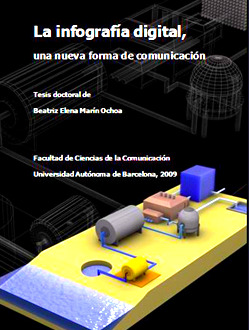Digital infography, a new means of communication

To find out how the reader receives the transmission of knowledge through digital infography is the aim of this PhD thesis. Infographics were characterized on typologies and the researcher conducted interviews with passive and active players of the communication process. The results confirm the success of digital infography, as well as traditional forms of communication, in the transmission of knowledge to any receptor.
21st century society is, by all means, distinctively affected by images. Imagery, however, has been intrinsically linked to humans since the onset of mankind. On the other hand, text-formatted stories have always prevailed in journalism, i.e. newspapers, radio and television. There is, nonetheless, a growing prominence of imagery, equally notorious in the worldwide web since its inception.
Consequently, over the past few decades, journalism has abruptly evolved into an image-dominated field, a presentation style in which images are significant, and in association with text, results in an organized, mixed form of communication characteristic of "infographic" presentations. Its capability of saying, communicating, transmitting, and representing things or events has led many books and authors to upgrade it to the rank of a language. Accordingly, it often yields a visual representation of reality quite different from that brought in by the vocal or written language.
Several authors share this perspective when they refer to it as the technique that represents information messages as a blend of photographic, information, design and content solutions. And, though some translate it as a term that originates from the link of information and graphics, which translated into Spanish results in infografia, some others use it to define the relationship between image and computer. Some others go beyond that to define it as a diagram representation of data.
To us, it has a generalized, incomplete, and imprecise meaning, which started to have relevance in the 90’s with the electronic media first, and then with cyber-journalism, notoriously with the development of special image-processing—including interconnectivity—hardware and software. Thus, acknowledgement that there is a knowledge exchange medium available to the reader through (1) his access to digital infography in a cyber-journalistic context, which results from the convergence of various stories, editions and production processes, and (2) the changes implicit in presentation adaptation from written information to digital infography, from its origin until it reaches the computer monitor. That is the focus of our research in this dissertation.
Hence, we designed a methodology which included:
1. Interviews with 17 recognized infographers from America and Europe. Half of them were in person. Some on two occasions.
2. Selection of infographies and characterization according to typologies. Such process was started with a study of 1,500 infographies until 32 of them could be debugged, using 16 in preliminary tests and 16 other with online infography.
3. Individualized polls to 96 experimental subjects in preliminary tests: infograms(64) and digital tests (32).
4. Individualized polls to 256 experimental subjects in our final test (online infographies). One half in Barcelona and the other half in Medellin.
5. Computer-aided statistical data analysis with the assistance of the Mathematics Department at UAB, Barcelona and the School of Social Sciences at UPB, Medellin.
Upon completion, we could verify that digital infography is as effective as digital text, printed text, digital images, or printed images in a fixed or movable format in the communication of knowledge to any subject. Consequently, it is a model for the communication of knowledge, a new attractive and interesting means of journalistic expression with a high potential which can create descriptive and narrative accounts of its own, and which deserves a different analysis as a result of its complexity.
References
"La infografía digital, una nueva forma de comunicación". PhD thesis defended by Beatriz Elena Marin Ochoa on 29 January 2010 at 11.00 am in the Sala de Graus of the Faculty of Communication Studies.


